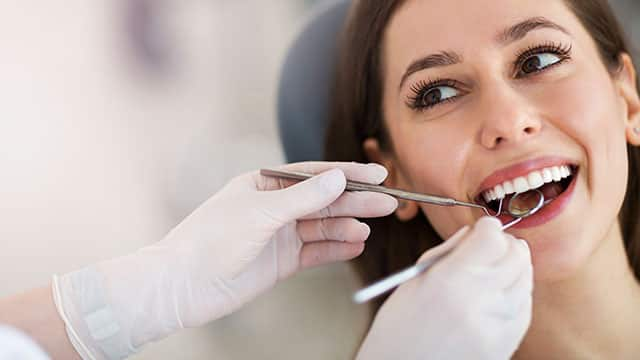Cavity Filling: The Procedure
To help you avoid pain, your dentist will administer a local anesthetic, so named because it only numbs the area being treated and doesn't put you to sleep. Since you'll be fully awake during the procedure, you'll be able to interact with your dentist. Lidocaine is a commonly used anesthetic during dental work.
Administering the anesthetic is a three-part process in which your dentist:
- Gently dries out the inside of your mouth with a piece of cotton or stream of air.
- Dabs gel on the gum tissue to numb it
- Injects the lidocaine into your numbed gum tissue
Once the treatment area is completely numb, you won't feel a thing as the dentist works to remove your diseased tooth structure and fills your cavity.
Did you know? Numbing the gum tissue reduces the sensation you feel when the dentist injects the local anesthetic. Interestingly enough, that sting isn't from the needle. Instead, it's a sensation created by the anesthetic as it works its magic to numb your gums and mouth.
Cavity Filling: After the Procedure
As the anesthesia wears off after your dentist has finished, you might feel some tingling in your mouth. Some people also have sensitivity in their teeth after a filling. For the most part, the sensitivity should fade after a few days.
Your dentist might give you pain relievers to help with any soreness right after a cavity treatment. In these cases, try to take it easy and avoid hard or sticky foods.
Cavity Filling: When to Call Your Dentist
Getting a filling should improve the health and comfort of your mouth, not make them worse. Do cavity fillings hurt? Although you can expect some tenderness and soreness during the first few days after you get a tooth filled, they shouldn't.
It's a good idea to call your dentist if that discomfort persists for more than a week. Your dentist can adjust the filling, so it's a better fit.
If you were fine right after treatment, but start to experience pain or discomfort weeks, months or even years later, it's also a good idea to check in with your dentist.
Fillings don't last forever. Plus, some filling materials have shorter lifespans than others. Your dentist can check out your teeth and let you know for sure.
Did you know? If you have more than one filling, such as a filling on an upper tooth and a filling on a lower tooth, you might experience galvanic shock — an actual zap in your mouth. This can happen if the two fillings are made from contrasting metals, such as dental amalgam on one tooth and a gold filling on the other. To avoid shocking yourself, have your dentist use the same material for each of your fillings.
Cavity Filling: Avoiding the Procedure
To avoid fillings in the future, make sure you follow American Dental Association guidelines:
- Make fluoride your friend by drinking fluoridated water and brushing with fluoride toothpaste twice daily.
- Avoid sugary foods and drinks, making an exception occasionally at mealtimes.
- Floss your teeth daily.
- Visit your dentist regularly for checkups to nip potential cavities in the bud.
Doing all of these things can help prevent cavities, but if you do end up with one, your dentist will work with you to make the process as painless and stress-free as possible.
FAQ
Do cavity fillings hurt?
While having a cavity filled may be uncomfortable because you are anxious, it is highly unlikely that you will experience pain. Your dental professional may put a numbing agent on your gums before administering an anesthetic such as lidocaine that completely numbs the treatment area so you can’t feel anything.
What can I expect during and after a cavity filling procedure?
After numbing the treatment area so you don’t feel anything, your dental professional will remove the diseased part of your tooth and fill your cavity. After the procedure your mouth will remain frozen for several hours and you may feel some sensitivity once it wears off.
How can you manage pain or discomfort after getting a cavity filled?
You may experience sensitivity after having a cavity filled. Avoiding extremely hot or cold foods for a few days can help. Your dental professional may advise an over-the-counter pain medication to provide pain relief. If pain persists for more than a few days, if it hurts when you bite down or your bite feels altered, contact your dentist. Sometimes the filling needs to be filed down so that your bite returns to normal.
This article is intended to promote understanding of and knowledge about general oral health topics. It is not intended to be a substitute for professional advice, diagnosis or treatment. Always seek the advice of your dentist or other qualified healthcare provider with any questions you may have regarding a medical condition or treatment.
ORAL HEALTH QUIZ
What's behind your smile?
Take our Oral Health assessment to get the most from your oral care routine
ORAL HEALTH QUIZ
What's behind your smile?
Take our Oral Health assessment to get the most from your oral care routine















